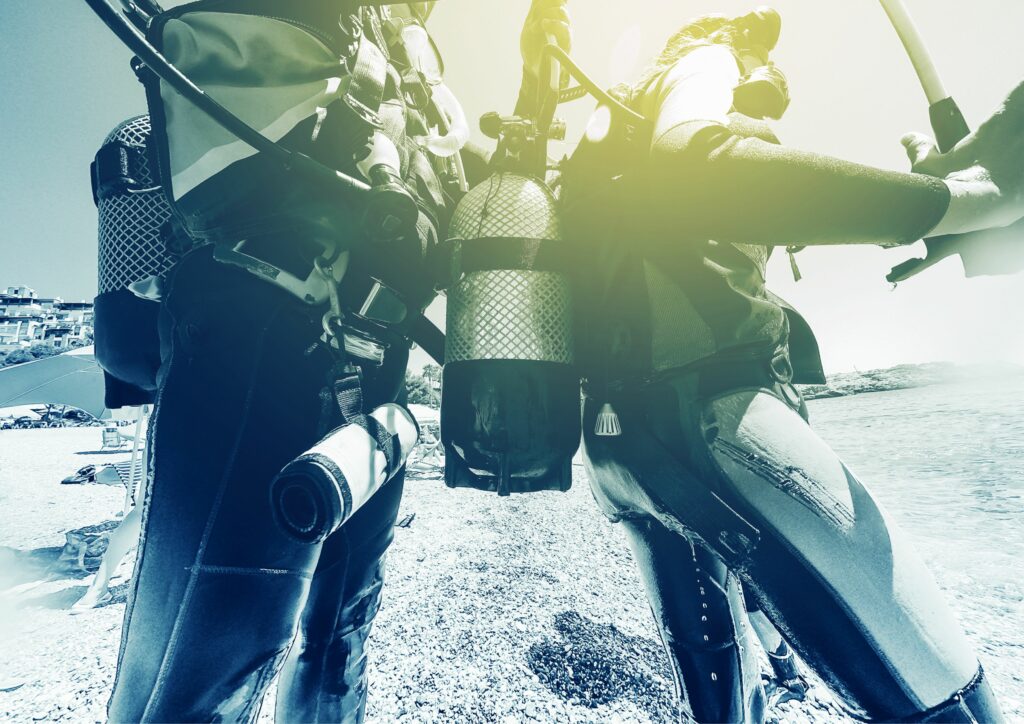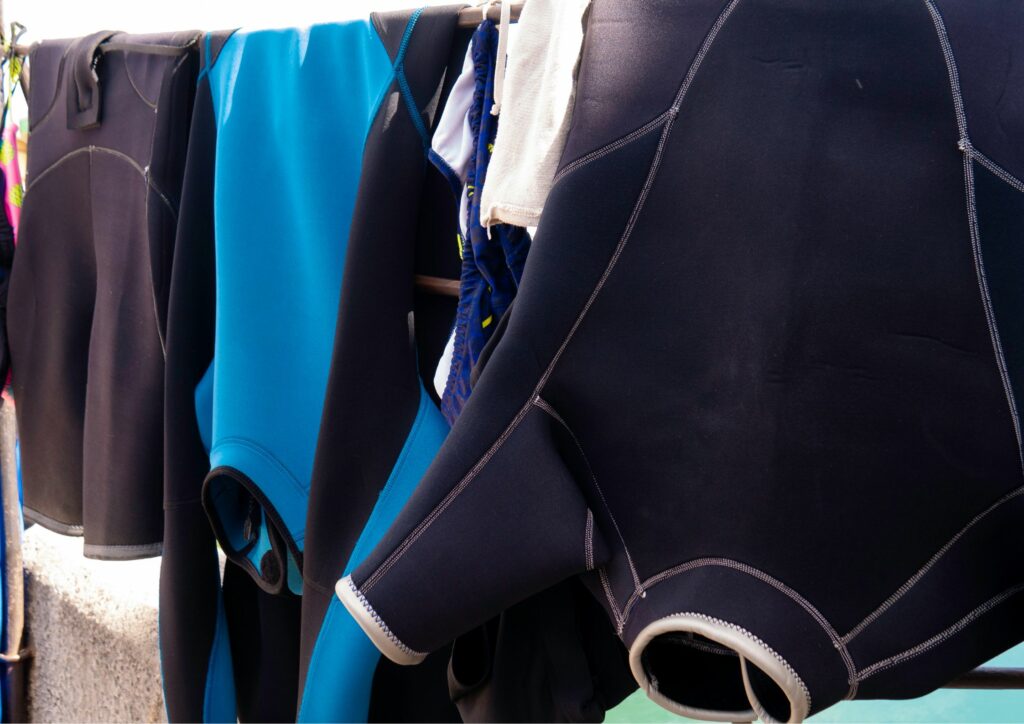Set off on an underwater exploration of scuba diving gear. Discover how the right scuba suit can make all the difference and learn how to choose between a dry suit and a wet suit considering crucial factors like the sea water temperature. Whether you are all set for deep sea diving or are planning some winter diving, knowing the differences, benefits, and limitations of both can offer you a safer, more comfortable dive.
Scuba Suit 101: A Basic Overview
Imagine this: you are about to embark on an incredible underwater adventure, surrounded by a different world of coral reefs, marine life, and pirate ship discoveries. All of this is made possible through the use of a scuba suit, a crucial piece of gear for any profound underwater exploration.
A scuba suit is a diving equipment protecting you from potential hazards underwater and providing insulation from the ocean’s colder temperatures. Two main types revolve around scuba suits: the wet suits and the dry suits. Each suit holds its unique specifications and purposes depending on your diving depth, water temperature, and the length of your dive. Like planning any other mission, understanding the fundamentals gives you a strong foundation, preparing you for that exciting, deep dive into the unknown.
Understanding Wet Suits
Wet suits, despite the paradox presented in their name, function by letting a thin layer of sea water penetrate the suit. This might seem counterintuitive at first, but it plays a crucial role in how wet suits perform underwater. This layer of water is quickly heated up by your body warmth, creating an insulating layer that provides resistance against the chilly sea environment. Think of it as a personalized heating system, except you’re submerged under water.
The efficiency of this self-warming mechanism is determined by the thickness of the wet suit – the thicker the suit, the better the retention of warmth. For those interested in recreational diving in areas with moderately cool temperatures, wet suits are an excellent solution. But what about dives in harsher, colder conditions?
Unfolding the Utility of Dry Suits

This takes us to the next type of scuba suits – the dry suits, a premium gear designed for diving during winter, or when the water’s chill is severe. As the name highlights, a dry suit’s essential function is to prevent water from reaching your body, keeping you dry throughout your dive. This is achievable because of the unique insulating properties and undergarments that dry suits come with, offering unparalleled warmth even in the freezing waters. It’s like bundling up in a cozy blanket, but underwater. With a dry suit, even the most frigid waters can be explored comfortably, potentially opening up new diving possibilities previously packed away during the colder seasons.
Wet Suit or Dry Suit: Making the Right Choice
Like many other decisions in life, choosing between a wet suit and a dry suit is significantly dictated by your particular circumstances and requirements. Are you into recreational diving with no intention of going too deep, and will your diving points be warm or temperate waters? Then a wet suit is your ideal companion, offering the right balance of practicality and functionality. On the other hand, if you’re a thrill-seeker intending to dive deeper into colder waters, love to dive during the icy winter, or planning extended underwater exploration, a dry suit would be the worthy investment. Both suits have their advantages, and understanding these will ensure you are suitably equipped for your next diving adventure.
In Conclusion: Dry Suits vs Wet Suits Unravelled for Your Bali Diving
When preparing Bali Diving, one of the most crucial decisions you’ll face is choosing between a dry suit and a wet suit. Both have their advantages, and the best choice depends largely on the dive conditions and your personal preferences.
Wet Suits: The more common choice for Bali diving, wet suits are designed to trap a thin layer of water between your body and the suit, which your body heats up, keeping you warm. Wet suits are ideal for Bali’s generally warm waters, which typically range between 26°C to 30°C (79°F to 86°F). They’re flexible, easy to don, and come in various thicknesses, with 3mm and 5mm being popular choices for Bali. The lightweight nature of wet suits makes them ideal for more casual or recreational diving where ease of movement and comfort are priorities.
Dry Suits: On the other hand, dry suits are completely sealed, keeping you dry by preventing water from entering the suit. They’re typically used in colder water environments, which may not seem necessary for Bali, but can be beneficial if you’re diving at deeper sites or during cooler seasons when temperatures can drop. Dry suits also offer superior insulation, making them ideal if you tend to feel cold easily or plan on doing multiple long dives. However, they require more experience to use effectively and can be bulkier and more challenging to manage in warmer climates.
In summary, for most Bali diving adventures, a wet suit will suffice, offering flexibility and comfort in the warm tropical waters. However, if you’re sensitive to cold, planning deep or long-duration dives, or diving during a cooler season, a dry suit might be worth considering despite its more complex use. Understanding the conditions and your comfort level is key to making the best choice for your Bali diving experience.

Wow, I never thought about how dry suits work! Thanks for explaining it so clearly. Can’t wait to try out a dry suit on my next dive.
Hi Yvonne, thanks for sharing your enthusiasm about dry suits! We’re glad to hear that our explanation helped you understand how they work. At Gill Divers, we strive to provide the best possible experience for all our divers, and it’s great to know that our content is helping to achieve that. If you have any more questions or need further guidance on choosing between a wet suit and a dry suit, feel free to reach out to us at [email protected] or call us at +65 6734 9373. We’re always here to help. Good luck with your next dive, and we hope it’s an unforgettable experience!
I totally agree with the post, it’s so important to choose the right gear for your dive. I’ve had some bad experiences with poorly fitting suits in the past and it’s not fun at all.
Thank you for sharing your experience, Rizal! We completely understand how crucial it is to have the right gear for a comfortable and enjoyable dive. At Gill Divers, we’re committed to helping our divers make informed decisions when it comes to choosing their scuba suits. Whether you prefer wet suits or dry suits, we’re here to guide you through the process. If you have any further questions or concerns, please don’t hesitate to reach out to us at +65 6734 9373 or [email protected]. We’re always happy to help.
I’m actually surprised at how much I learned from this post! I had no idea there were so many factors to consider when choosing between a wet suit and a dry suit. I’ll definitely be keeping this in mind for my next scuba diving adventure.
Thank you so much for sharing your thoughts, Shanti! We’re thrilled to hear that our post helped you learn something new. Choosing between a wet suit and a dry suit can be overwhelming, but understanding the factors involved can make all the difference in ensuring a safe and enjoyable dive. If you have any more questions or concerns, please don’t hesitate to reach out to us at Tel: +65 6734 9373 or Email: [[email protected]](mailto:[email protected]). We’re always here to help. Good luck with your next scuba diving adventure!